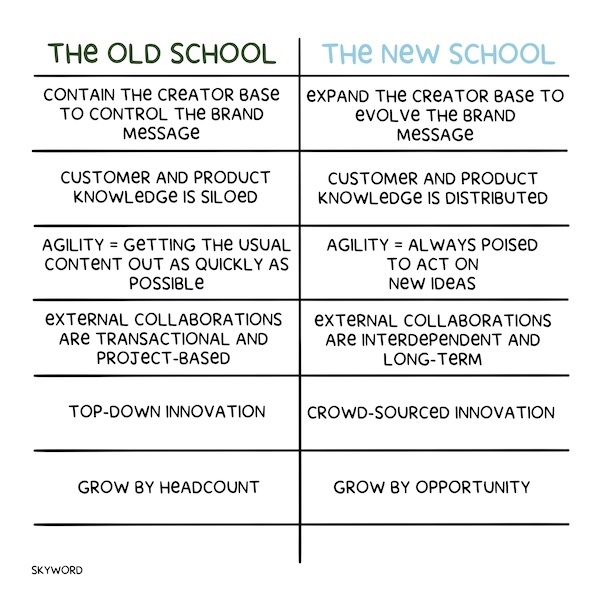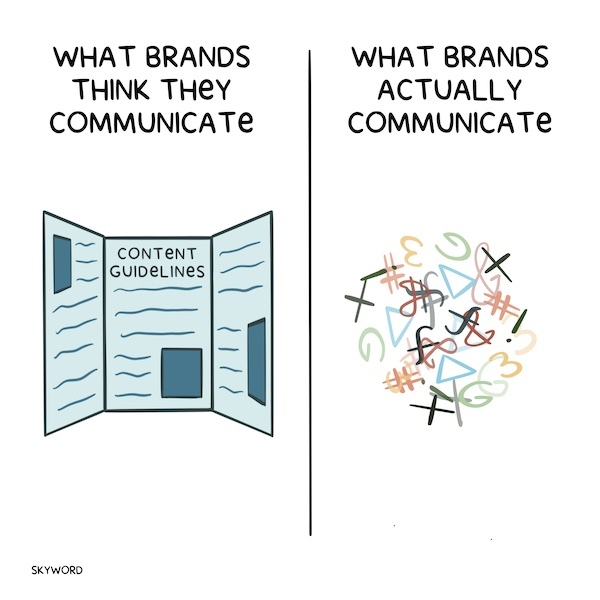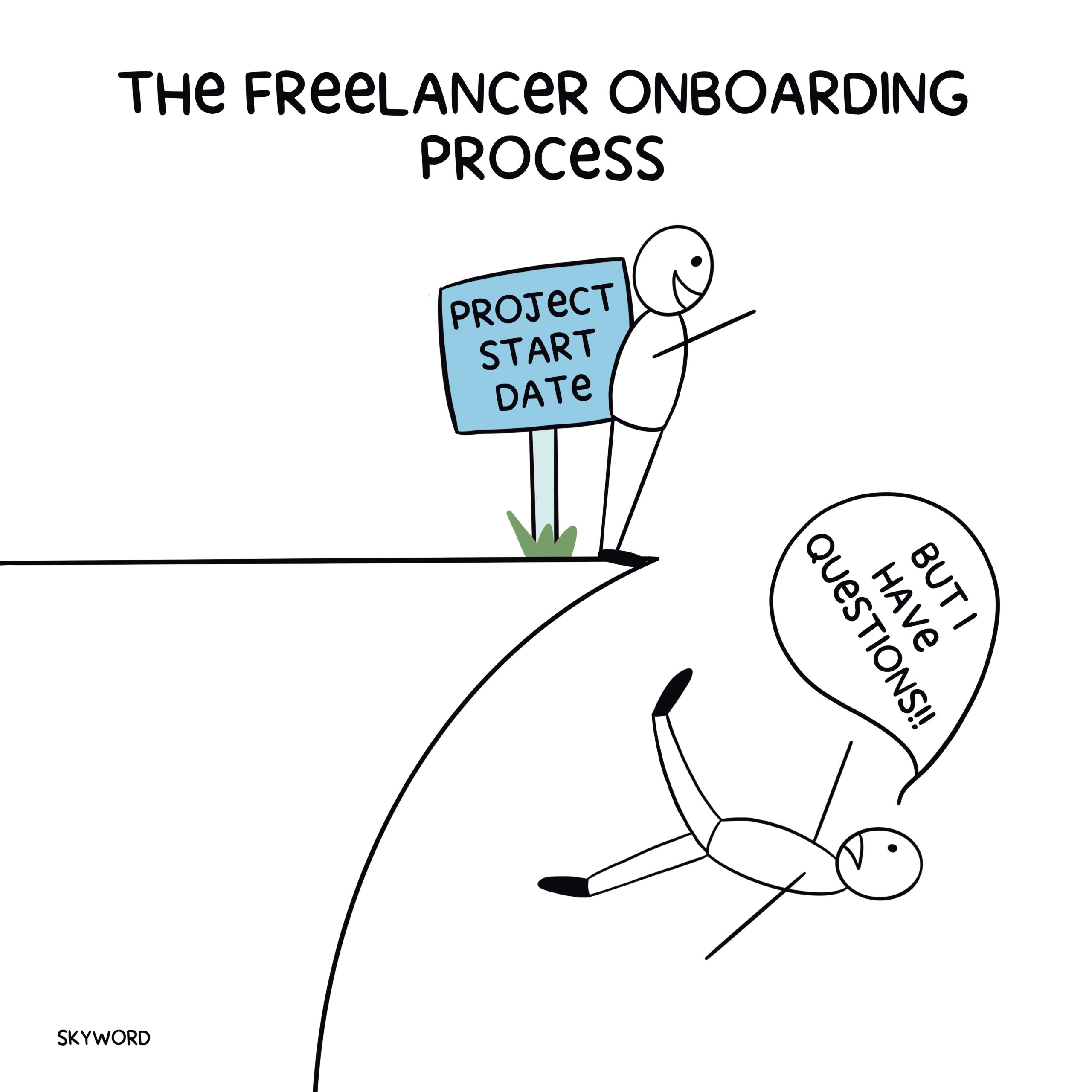Content Creation
Becoming a Flexible Powerhouse of Content Creation
By Andrew Wheeler on June 22, 2021
Subscribe to our monthly newsletter, Content & Context, to receive future insights and updates on the content marketing world from Skyword CEO, Andrew C. Wheeler.
In the beginning, creative ruled marketing. Then tech took over.
But the future? It's all about talent.
I'm not talking about bloated orgs and endless agencies of record. We've been there, done that.
I'm talking about flexible collaboration models designed to leverage the right talent at the right time.
Blended teaming is now an undeniable force reshaping workplace.
In 2020, 90 percent of business leaders reported freelance talent platforms would be very or somewhat important to their organization's future competitive advantage.
What makes them so important? Forty percent of freelance talent platform users say that highly skilled freelance workers helped improve their speed to market, boost productivity, and increase innovation.
These days, great talent comes with great leverage. Especially in a post-COVID world, top creators don't necessarily want full-time employment. At the same time, organizations are under pressure to reduce fixed costs—marketing, in particular.
Our research reveals that 73 percent of brand marketers who use freelance creators today plan to rely more on them in the next 1-2 years.
Leveraging freelance talent gives brands flexible bandwidth, unlimited choice, and the ability to scale content quickly. Scale is the #1 motivator behind blended content marketing teams, according to our survey respondents.
But what are the implications of a shift from project-based content creation to an always-on, on-demand creative workforce?
For one, marketing doctrine is morphing.
Here are just a few examples:

Notice a theme here?
Brands are waking up to the fact that old command-and-control policies actually stifle the creativity and agility they're meant to support. Blended teams are proving to be more nimble and innovation-centric.
Besides the marketing mindset, there are ground-level changes brands need to make to scale freelance collaboration effectively.
Our recent research provides some clues into the areas ripe for transformation.
1. Bridge the brand knowledge gap.
Fundamentally, a marketer's role is to externalize the brand. Yet nearly a quarter (23%) of brand marketers cite transferring brand knowledge as the #1 challenge of working with freelance creators.
To get creators on the same page, content marketers need to be equal parts curator and translator—centralizing information typically locked within brand silos and distilling it into resources that are easy for content creators to use.
At a minimum, brands should have an easily digestible set of content guidelines on deck to streamline this task, along with clear examples of what "great" content looks like. Supplementing guidelines with briefs that detail the brand's key points of view, which solutions ladder up to them, and which internal SMEs a creator can reach out to for more information also helps.
In a recent discussion with a panel of freelance writers, it was estimated that only around 10 percent of brand clients have content guidelines to share with creators. Often, brands hand over cursory assignments or lengthy presentation decks and file folders full of information it's up to the creator to interpret.
Both faulty approaches send an immediate signal to creators that a brand may be challenging to work with.

2. Expand your talent-sourcing strategy.
I was surprised to find that 60 percent of brand marketers still rely heavily on word-of-mouth recommendations to find freelance talent.
I have a theory that word-of-mouth recommendations make marketers feel like they're making safe bets. But, as any HR leader will attest, holding out for referrals isn't a sustainable way to build a continuous stream of talent—nor is it a guarantee that those freelancers will pan out.
Most freelance talent platforms offer a couple of clear advantages that are changing the game for marketers: 1) Immediate access to a broad base of vetted creators searching for work. 2) Automated payment processing with centralized invoice and payments tracking.
Brand marketers must be prepared to champion the value of networks internally and evaluate the level of network integration needed to meet internal needs while appeasing new stakeholders in the procurement process, namely their finance, legal, and IT teams.
Content marketing-specific platforms house the types of creators marketing teams usually need and support marketing-centric workflows that consider different content types, feedback tracking, scheduling, and publishing on a continuous basis.

3. Expect a learning curve.
The ability to trust creators goes hand in hand with the willingness to invest in them.
Think for a moment about how your training investment in freelancers differs from that of full-time employees. It's true, freelance creators are used to getting up to speed quickly, but they should be afforded at least some of the same grace granted to full-time hires when it comes to acclimating to brand expectations.
The first few assignments are where the rubber meets the road. Common missteps at this stage include underestimating the time it will take to onboard and manage freelance talent (30 percent of brand marketers said investing this time was their #1 challenge) and failing to hold freelance creators accountable for the "final inch" in the content creation process (23 percent of brand marketers said "revising content myself" was the top drain on their time).
Creator management can't be a side hustle for already overstretched marketing resources. Brands need a dedicated point person (or people) responsible for the creator experience, especially minimizing the amount of work that falls onto the marketing team.
That last point is a big one. Unpack what "on-brand" content looks like. What's typically lacking in content that needs revising? Would it help to share a lexicon of legal-approved terms? To more clearly define the solution you want to drive to in the creative brief? To provide a list of third-party sources it's acceptable to cite?
There's a reason the learning process is described as a curve, not a cliff.

4. Reimagine creative workflows.
Bringing freelance creators into the fold can be a shock to the usual modus operandi. Content workflows have to work—for brands and for the creators who depend on them. Twenty percent of brand marketers cited managing schedules and maintaining deadlines as their #1 challenge of working with freelance creators.
This is often a symptom of unwieldy internal processes. Suddenly increasing the complexity and scale of content creation puts stress on manual tasks like updating spreadsheets, checking calendars, and tracking documents across platforms.
Seek to automate the essential—in other words, tasks like assignment creation, scheduling, review governance, and feedback tracking.
The right content marketing platforms bring structure to these aspects of the collaboration process, making more interdependent work possible with greater visibility given to brand stakeholders who need it and less effort from the marketing team.

At the end of the day, brands have to look at the relationship with freelance creators as bi-directional and long-term, rather than one-sided and transactional.
Understanding how to share your brand with others, investing in onboarding and ongoing communication, and using technology to lubricate friction points in highly interdependent workflows is what will pave the way for marketing to be what it was meant to be: a flexible powerhouse of content creation that drives brand growth.

